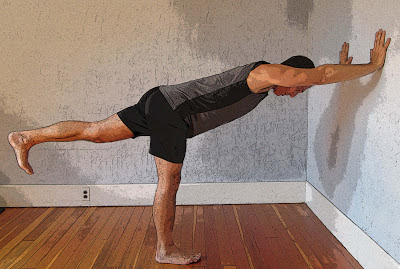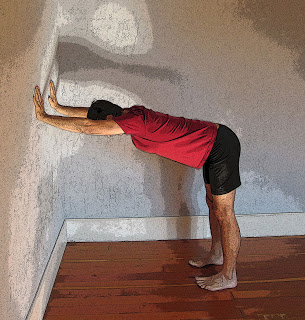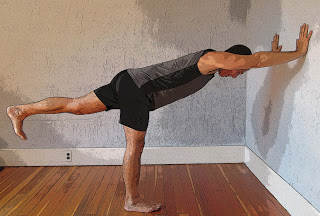by Baxter and Nina

Warrior 3 is the third pose in our upper body strengthening series because this pose provides unique upper body strengthening with little or no weight bearing on your hands. Before providing instructions on how to do the full pose (coming soon), which can be quite challenging, we’re providing an alternative using the wall that is accessible to almost everyone.
Warrior 3 is unique in that in this pose you keep your torso, arms, and one leg parallel with the floor. In this position, gravity challenges you to keep yourself upright instead of folding over your front leg. All the musculature on the back of your body has to work actively to keep you in this position, including your hamstrings and buttocks along with all the spinal muscles up to the base of your neck. You are also building strength the arm muscles required to keep your arms overhead (the position known as flexion), including trapezius, anterior and posterior deltoid, serratus anterior.
To enhance the strength building aspect of the pose when you are using your hands on the wall, use the lightest touch possible on the wall so your arms still have to work to hold themselves up. Touching the wall with just your fingertips is the most effective, but you can still gain strength building with your palms lightly on the wall if you prefer full contact with the wall for support, balance, or even just a sense of security.
Instructions: Start by facing a wall, standing about one foot away. Place your hands on the wall shoulder-distance apart, either with palms or your fingertips on the wall. Depending on your hamstring and hip flexibility, your hands should be somewhere between shoulder height and elbow height. Next, bend your knees and push your hips back away from the wall, and, keeping your buttocks over your heels, slowly walk back until your arms and torso form one long line approximately parallel to the floor.

You are now in Half Downward-Facing Dog pose (see Featured Pose: Half Dog Pose at the Wall for photos and detailed instructions of moving into this pose). From here, push your fingertips or palms firmly into the wall as you press your sitting bones away from the wall. Then shift your left foot to the right, at the mid point between your feet, while allowing your hips to shift a little to the left so you are balancing on the left foot. Then swing your right leg up and back, in line with your arms and torso.

Be careful to avoid letting your chest sink toward the floor, because hanging from your shoulder joints puts a lot of strain on them. Instead of feeling a stretch in the shoulders, you want a feeling of even strength around your shoulder joints. So think about lifting your chest up into your shoulder blades, as opposed to dropping your chest down toward the floor and aim for a feeling of completely parallel line (if you are flexible) or an even slope (if your hamstrings are tight).
One you’re in the pose, try lightening the press of your hands on the wall so you can feel the work of your back body’s musculature keeping you in position. With your raised foot slightly pointed, lengthen through your hell away from the wall. Start by staying in the pose for six breaths or so and gradually over time work your way up to 1.5 to 2 minutes.
To come out of the pose, release your right leg down to the floor, bend your knees, and walk in toward the wall. Repeat on left other side.
Cautions: This pose requires a lot of back strength, so if you have lower back issues, you may need to modify the pose by placing your hands higher on the wall or by keeping your lifted leg slightly bent. If you have a hamstring strain, if you feel any strain in the standing leg, bend it slightly so you don’t aggravate your injury.
Follow Yoga for Healthy Aging on Facebook ° To order Yoga for Healthy Aging: A Guide to Lifelong Well-Being, go to Amazon, Shambhala, Indie Bound or your local bookstore.


Most of the students in the chair yoga class I teach could not get into that position. When I have them do half dog pose against the wall, their upper backs are rounded and the heads are too high. I tell them to aim at getting the ears between the upper arms, but their ears end up being a good 6 inches or more too high.
I have them start out standing and bring the arms out straight in front, parallel to the ground. Then we plug the arm bones back into the shoulder socket and raise the arms overhead. That puts the arms and shoulders in the correct position for half dog against the wall. But when I have them lean forward, hinging at the hips, if they go past 45 degrees from vertical they lose that alignment and their backs round and the heads pop up.
A few of my students have taken classes with me for over 3 years and only now are they able to do a good half dog against the wall. For older people who are not used to doing yoga, this pose is much harder than it looks!
Joanne
Thank you. That makes me feel better. It is absolutely harder than it looks.